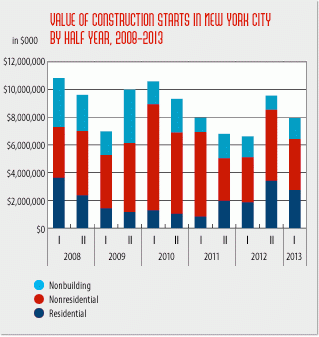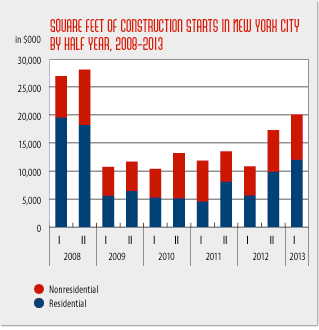
Surging residential sector sparks 10 percent increase in new york city construction starts in first half of 2013
A New York Building Congress analysis of McGraw-Hill Construction Dodge data finds that $7.9 billion worth of construction projects were started in New York City in the first half of 2013, a 10 percent increase from the first half of 2012, when construction starts reached $7.2 billion.
In another sign of increased building activity, the Building Congress found that $16.8 billion in projects were started in all of 2012, a nearly 10 percent increase from 2011, which saw $15.3 billion in construction starts.
The data encompass all project starts in New York City, including new construction as well as alterations and renovations to existing structures, and reflect the estimated value of each initiated project through the entire period of construction.
Residential Surge
The recent increase in construction starts is owed entirely to the housing sector, which appears to have fully recovered from the financial downturn that started in 2008. The value of residential construction starts rose 45 percent - from $1.9 billion in the first half of 2012 to approximately $2.7 billion in the first six months of 2013. Back in the first half of 2011, New York City registered just $981 million in residential construction starts.
For all of 2012, residential starts reached $5.3 billion, its best annual showing since 2008, when all housing starts were valued at $5.9 billion.
The top two project starts by value – and five of the top ten – in the first half of 2013 occurred in the housing sector, which was led by the $365 million Durst Fetner project at 625 West 57th Street and the Monian Group’s Atelier II development on West 42nd Street.
"We are continuing to see some very strong numbers coming out of New York’s residential sector," said New York Building Congress President Richard T. Anderson. “Over a twelve month period from July 2012 through June 2013, the value of residential construction starts topped $6 billion. We haven’t seen those types of numbers since the pre-recession building boom.”
Non-Residential Registers Small Decline
The value of new construction starts in the non-residential sector, which includes commercial office and retail buildings, public and private schools and universities, as well as cultural and entertainment venues, declined slightly – from $3.8 billion in the first half of 2012 to $3.7 billion during the same period in 2013.
The two biggest starts this year in the non-residential sector were construction of the 72nd Street Station and ancillary buildings for the Second Avenue Subway, valued at $258 million, and a $252 million academic building for the New York City College of Technology. The biggest office construction start during this period was the $150 million 7 Bryant Park tower.
"Overall, the data for the non-residential sector are encouraging,” added Mr. Anderson. “While construction starts ticked down slightly in the first half of 2013, it’s worth noting that $5.1 billion in projects were commenced in the second half of 2012. Our expectation is that we’ll continue to see a wide range of commercial and institutional projects break ground in the coming months and years.”
Infrastructure Starts Hold Steady
"Non-building" construction starts, which encompass bridges, highways, mass transit, water supply systems and other infrastructure, held steady at $1.5 billion for the first six months of 2013. Non-building construction starts reached $906 million in the first half of 2011 and $1.7 billion in the first half of 2010.
The biggest infrastructure starts (by total value) in the first half of 2013 were a $236 million deck replacement project for the Verrazano Bridge and a $182 million rehabilitation of the Marine Transfer Station at East 91st Street.
“It is a bit concerning that infrastructure projects are lagging behind the residential and nonresidential sectors in terms of new construction starts,” added Mr. Anderson. “While infrastructure spending is robust at the moment – thanks to ongoing work on a number of big ticket transportation projects – there is a question as to whether enough new work is being generated today to maintain spending levels in the future once these mega-projects wind down.”Charts and Diagrams

Source: McGraw Hill Construction Dodge*

Source: McGraw Hill Construction Dodge*
* Dodge data used for this analysis can be purchased at dodge.construction.com



